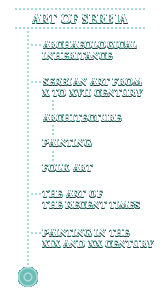|
The frescoes preserved from the period before Nemanja supports the value of the church buildings. The mural paintings in PETROVA CHURCH from the 10th century are of great importance. The oldest layer was created immediately after the construction and covers the cupola tambour areas and upper areas beneath the cupola. In the tambour there are five scenes from Christ's life.
The appearance of Stefan Nemanja influenced both construction and painting in Serbia. The painting of all Nemanja's foundations was carefully planned. Frescoes of Nemanja's time marked the appearance of glittering art creations that became, in the following few centuries, a close part of the foundations of his descendants, church dignitaries and landowners.
A small painting inheritance from the areas across Sava and Danube from the 16th and 17th century (Krusedol, Serbian Kovin, Petkovica, Novo Hopovo, Orahovica) show a crossing of painting trends whose founders are in Sveta Gora, Italian-Crete art and local traditions.
The rebuilding of the Pec Patriarchate in 1557 is marked in the history of The Serbian Church Organization and in the Serb population under the Turks as an exceptional event and as a certain crossroad in its faith. In the development of art it had a far-reaching significance. This fruitful age can be divided into three stages : in the first stage, from 1557 to 1614, the most significant architectonic creations and the most harmonious paintings by style were created, whose artists belonged predominantly to the Pec art workshop. The second stage from 1614 to 1647 was marked by a renaissance of the painting activity and the third stage, from 1647 to 1690, is characterized by the activity of one painting workshop originating from northern Greece and of a few domestic painters.
|



